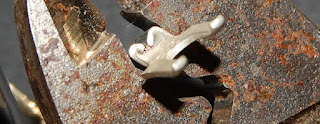In lieu of fixing things, disassembling stuff or making racket and a mess near the work bench I've been re-familiarizing myself with the Akai MPC 2000xl. This machine was the backbone of essentially all of my audio work from 2000 through 2004 and was rotated into the neglect pile sometime in the window of 2005 due to an interest in less constructed work.
While constructivist (not to be confused with the art movement) leanings return, musical taste and direction has drifted a bit since then. So while a lot of the sounds I had created remain useful, others (primarily in the brass/upper register department) suffer from being overused to my ears or to pulling up short in the quality department. Fresh cymbal sounds became a priority.

In the moving music store clean-up a year ago I went through the large pile of used brass that was deemed unsaleable for one reason or other, hand picking a smaller stack of cymbals that exhibited sonic characteristics that were interesting or useful. The main justification for sorting, hauling and retaining a pile of broken cymbals being sampling them into digital drumsets, which is exactly what has begun.

"Appropriate microphone technique involves doing whatever needs to be done in order to place the microphone in the perfect position as dictated by the needs of the recording. Compromise is not acceptable."
I captioned that picture (out of context) elsewhere, but, having a bit of freedom with mic placement can indeed produce favorable results. Without the concerns of a heavy handed drummer wrecking microphones, one can explore the stupid sort of placements that deliver subsonic response from what is commonly considered a high frequency instrument.

So, in the early hours before others have risen I may be turning off all fan bearing devices and hitting cymbals as the sun creeps up from the east.









